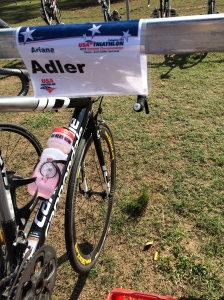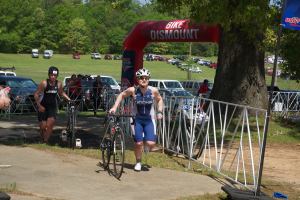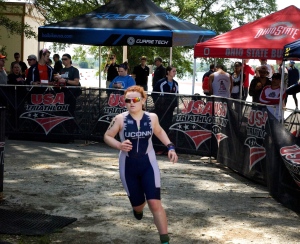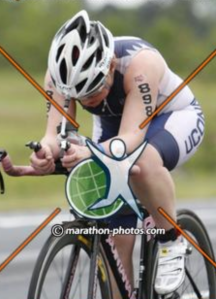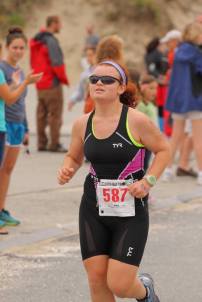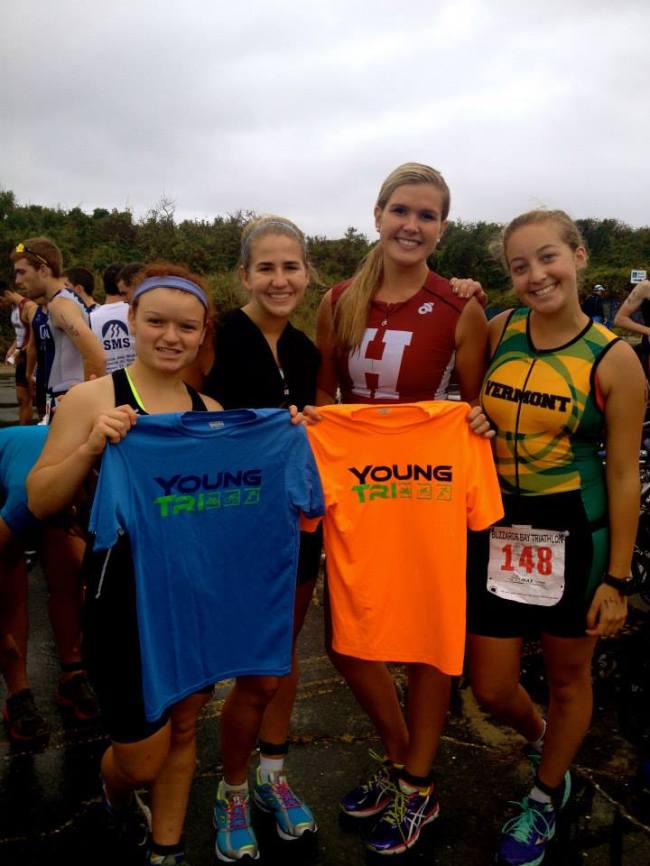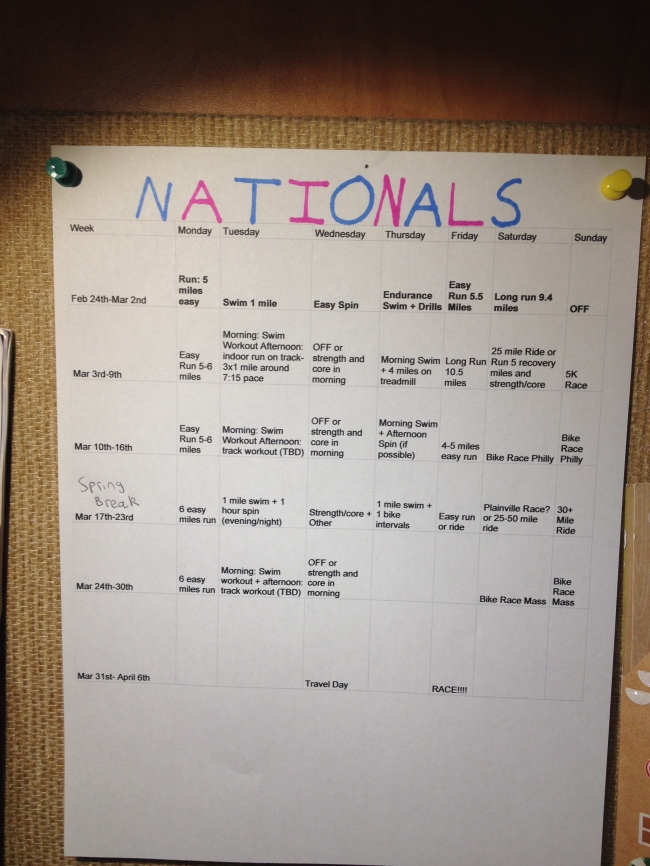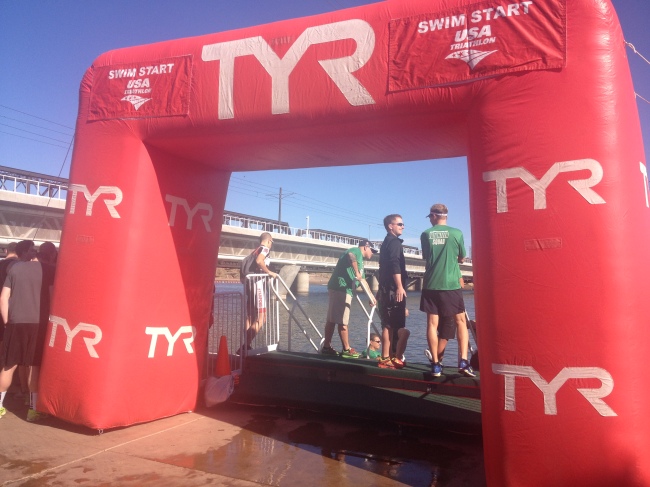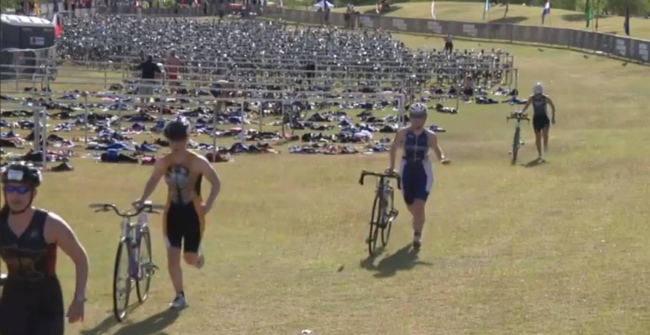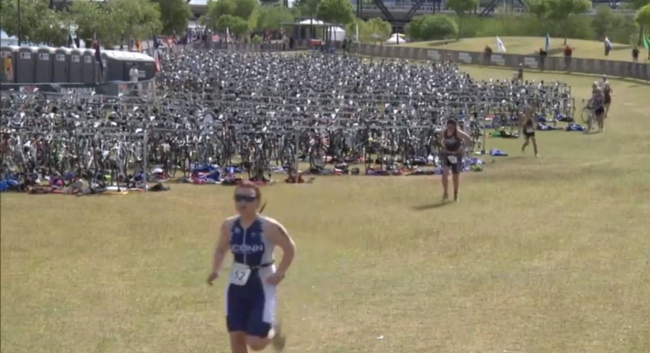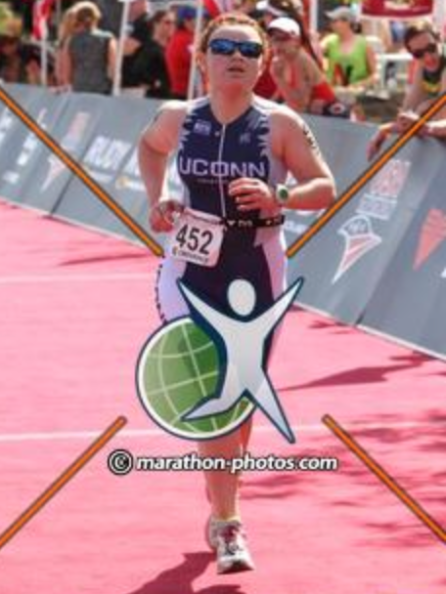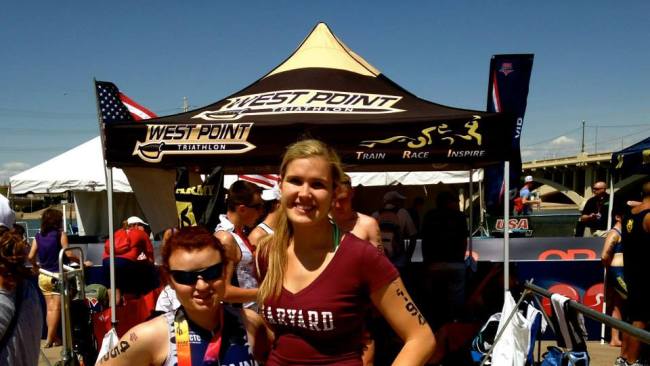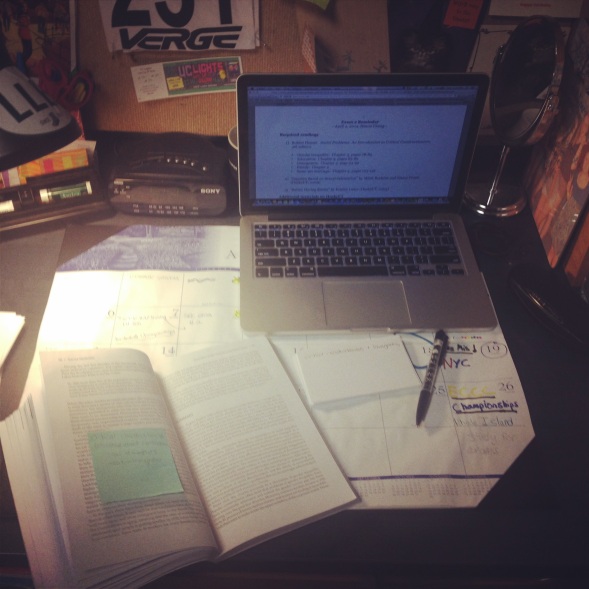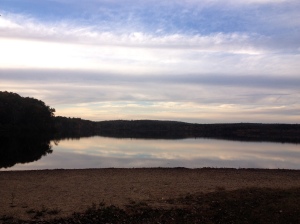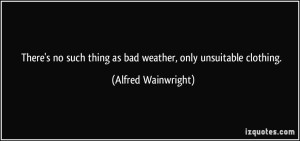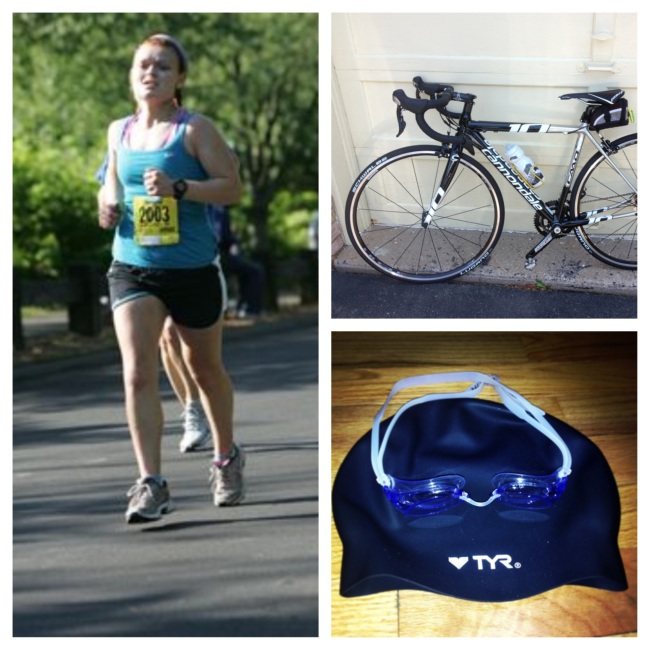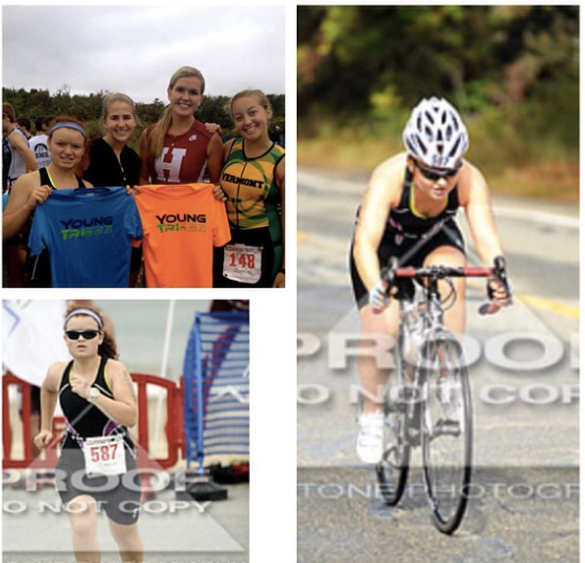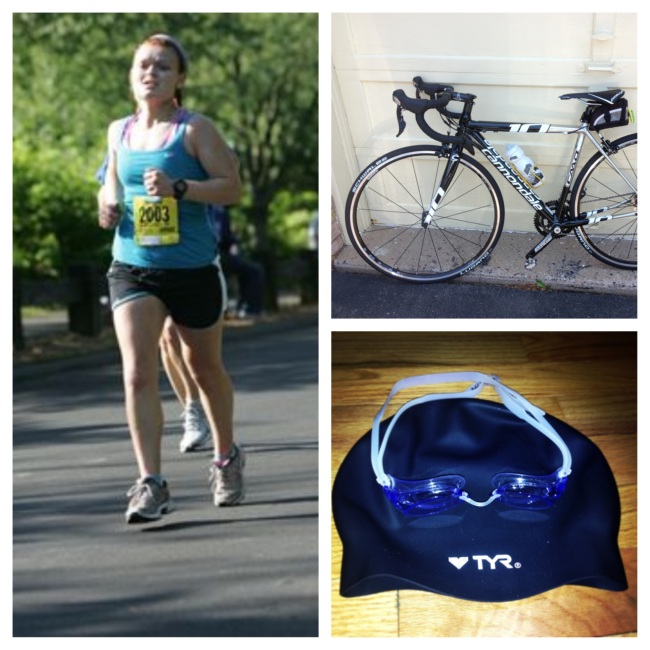-
Recent Posts
Archives
Categories
Meta
Getting Back on the Training Wagon
Saying that 2017 has been a year of change is quite an understatement. One year ago I was a senior at UConn cramming in GRE studying while completing PT shadowing hours and getting ready to make my first attempt at applying for DPT programs. I was president of the club triathlon team where I tried to take advantage of the group training, coaching, and fun collegiate atmosphere for the last time. The womens team had just won our conference, and I was stocked to start working toward collegiate tri nationals in the spring. I was finally done with the challenging intro science lecture and lab courses and had a much less stressful academic semester. I lived in a nice 4 bedroom, 2 bath on-campus apartment with 3 girls whom I got along with well. Life was good and I was finally at a point where I was comfortable in my current situation. It was only the unknown of post-graduation that stressed me out. I was fully expecting to get denied from all 9 programs which I applied to and was mentally preparing to take a year off to improve my application.
Well, I made it. One year later I am in a very different place. I live in Boston with one of my new classmates. I am enrolled in Simmons College DPT Program, a school I can honestly say I only applied to because it was in Boston (but have since ended up loving for so many other reasons!). I recently got a part-time job at a bike shop/tour company. I’ve seen my family much less that when I went to school an easy 45 minute drive from home. My school is no longer a state school located in a rural town but instead is a tiny campus located in the bustling Longwood Medical Area of Boston. I don’t have a car anymore and walk, bike, or take the T everywhere.
In addition to being in a new setting, feeling much more independent and adult-like than in undergrad, having a much more rigorous academic schedule, and having to figure out a way to be somewhat social and meet new people, what has been very difficult for me is not training anymore.
My program started with an intensive summer anatomy course. I can honestly say I’ve never had to study so much. Fortunately, Simmons has been very honest in the entire application process and did not try to hide how time-consuming the class would be. Our professors strongly discouraged students from having any sort of job outside of school during the 2 months of anatomy. It was honestly the first time where I cleared everything from my schedule for 2 months, so I could just focus on learning. Of course, this was a major change from undergrad where even during my most challenging semesters, I still had time for extracurriculars. During anatomy, it was difficult to find times for me to get workouts in.
Because of my time constraints, I tried to make my workouts effective. I did intervals on the bike trainer 1-2 times a week and threw in a few 30 minute runs as well. Most of the workouts weren’t super enjoyable, I wanted to make sure I maintained a minimal base fitness so workouts weren’t too painful when I eventually had more time. It worked, but I never really got back into training even after anatomy was over. I definitely worked out more, but I think there’s a big difference between exercising and training.
Training involves giving each workout a purpose in order to achieve some end goal. Exercising is simply performing some sort of physical activity to live a healthy lifestyle. While exercising is great, training for triathlons is my hobby and has been a major part of my life in the past. It was harder than I anticipated to get back into a full training schedule even when I began to have more time.
Training during undergrad was honestly so easy logistically. Our coach would upload workouts for the team, and we would complete them either with her at a practice or with each other. My schedule was flexible and I could almost always find ways to fit it all in. Having a race schedule was also helpful because it gave me a goal to aim for. Now I don’t have the convenience of a triathlon club right outside my door, a coach, or discounted races and travel. I no longer show up at the pool and randomly see teammates and I can’t just post about meeting at the husky statue for a casual afternoon ride. Although I want to join a triathlon club in Boston, it’s been hard to find one that is as convenient as a collegiate team was. I’ve realized that even if I can’t find a new team right away, I should still try to implement at least some type of training plan.
Not only does a lack of a training plan make me less focused, but last weekend my dad jokingly made fun of my easy 4 mile runs that I’ve started calling my big workouts. Thanks, Dad. As I start to receive syllabi for my fall classes and become overwhelmed in the 250 page workbook amongst other work that I need to complete before school starts, I realize how important having a training plan will be as I continue on with PT school. While anatomy is suppose to be the most intense part of the program, the fall will be another transition as I will have to get use to balancing 5 classes and a part-time job. In undergrad, I would’ve taken this head-on, but anatomy made me get use to uncountable rest days and a complete lack of a training plan. It’s hard to tell myself that even without a goal race I can get back to training with a purpose. At the end of the day I need some fun to balance out the stress of grad school. If I can go on a group run or ride, that would be amazing, but if not, it’s not an excuse to let training fall off the wayside.
There’s a reason I was able to get through anatomy: I thought of the class like an endurance event (so nerdy, but I had to implement any mental tricks to motivate myself). It was going to require discipline, persistence, and a deliberate plan to reach the end goal. While there is still much unknown of how hard the fall semester will be, I need to have a positive attitude toward it and remind myself that just like a tough workout, PT school isn’t suppose to be easy. I should be uncomfortable at times. It’s the only way I’ll be able to learn and mature. Training for triathlons is another way to reinforce that the journey won’t be easy, can be fun along the way, and will certainly be worth it in the end!
Posted in Uncategorized
Tagged biking, college, cycling, physical therapy, pt school, running, school, training, triathlon, triathlons, uconn
Leave a comment
NEACSM Annual Fall Meeting 2015 Recap
One very large part of my life that often gets left out of this blog is my studies. Currently I am a junior at UConn studying exercise science with hopes of attending physical therapy school after graduation. My ultimate goal is to incorporate fundamental concepts of sports nutrition, exercise physiology, and physical therapy.

One of the reasons I chose my major is because of UConn’s top ranked kinesiology department (seriously, all of the professors amaze me on a daily basis!). I also believe that the opportunities available will set me up to work toward and achieve my future career goals.
Upon entering the kinesiology department at the start of last semester, the professors informed my class about the New England American Conference of Sports Medicine Fall Conference in Providence, RI. I had heard about this conference over the summer and had already thought about attending it to learn more about the field among professionals outside of the classroom. My plans became solidified when I learned I would be given extra credit for attending the conference. It was a win-win situation!
For class, I had to write a paper reviewing my experience at the NEACSM conference. I recently found it while trying to clean up my desktop and thought it might be of interest to those in the exercise field or those looking to attend an ACSM conference in the future.
Here is the synopsis of the lectures I attended on the Friday of the 2015 conference:
“A Gluten-Free, All-Natural, Free-Range Tutorial: Helping Clients Decode Food Package Labeling”
October 16, 2015, 9:40-10:40 am
Beau Greer, PhD, CSCS, Sacred Heart University
Greer’s lecture focused on helping health professionals and their clients decode food-packaging labels. Today consumers see many labels on food products and often it’s hard to decide what they really mean. If a baked good is “gluten-free,” does that make it’s healthier than a regular product? Is beef from “grass-fed” cows more nutritious? Why do media outlets tell consumers that GMO’s are dangerous? All of these questions have arisen in roughly the past decade as society has begun to question the ingredients we put in our bodies. Greer broke down all of these confusing labels for the audience.

There are two types of labels that food producers can choose to add to their products: external and internal. Most claims are internal meaning that they are based on scientific (generally quantitative) information. For example, the term “gluten-free” means that there is less than 20 ppm of gluten in the product. Greer explained that this amount could still make a very sensitive person have a reaction if they have an empty stomach. Fermentation, he said, takes care of any of these concerns. Although the FDA regulates the term “gluten-free”, Greer noted that many foods that are already gluten-free are now labeled to make their product more marketable to health-conscious consumers. While only a very small percent of the population suffers from celiac disease or gluten intolerance, many more people are looking for these “gluten-free” products because they believe that gluten-free is healthier; yet, producers usually replace the gluten with less nutritious alternatives such as potato starch. It’s important to remind clients to focus on eating a wide range of nutrients rather than selecting a product because it is “gluten-free”.
Another internal claim is “grass-fed”. Greer said that it is more important to eat a lean part of the cow rather than focus on what the cow eats. Many consumers believe the percent fat listed on the packaging of beef tells how much fat calories are in it, but really the percent tells how much of the weight of the beef is fat. Food producers aren’t trying to tell consumers what’s in their food, but rather are trying to make consumers believe the product is healthy so they will purchase it.
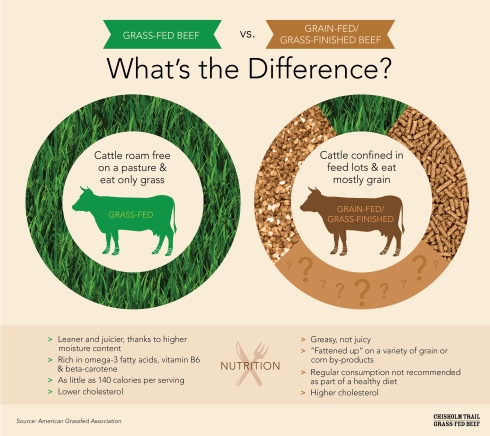
Not that I eat beef…but this is a good chart for comparison.
Many times there isn’t scientific evidence that proves that eating or not eating a certain product or type of food is beneficial. For example, there has not been significant evidence stating that GMO’s are dangerous, yet many consumers choose “non-GMO” products just because it sounds better. There may, however, be moral reasons to avoid GMO’s, which Greer explained is an external claim.
When producers appeal to consumers’s morals, they are using an external claim. These labels are not based on quantitative, scientific data, but rather on the moral views and emotions of the consumers. Examples of external claims are the labels on eggs such as “animal welfare approved” or “free-range”. 50 years ago, consumers had very limited options for eggs, but nowadays there is an extensive selection at most grocery stores. “Animal welfare approved” simply means that the chickens can go outside. ”Free-ranged” means that the chickens can go outside at 5 weeks old, but it is not their normal lifestyle. “Organic” is much harder to define. Usually it is associated with smaller farms. Overall, Greer says that there aren’t any health benefits or disadvantages to buying eggs with these claims on them; however, morally some consumers may feel better about buying a certain kind of eggs over the other (e.g. to support small businesses or animal rights).

My favorite part of this picture: “Are fertile eggs more nutritious?”
While these claims may still seem very confusing even to most health care professionals, Greer said that it is important for consumers to focus primarily on choosing the right foods (meaning eliminate processed products and increase consumption of real foods) and then if they can afford it, buy a product that has a claim that they feel is worth paying for.
“Sports Nutrition in the 21st Century: Do as I Say, Not as I Do”
October 16, 2015, 10:50 am-12:00 pm
Eric Rawson, PhD, FACSM, Bloomsburg University, Pennsylvania
Rawson’s talk focused on sorting through the nutrition advice given to strength athletes both from health care professionals and run-of-the-mill athletes who simply have their own experience to rely on. As professionals, it is crucial to integrate our personal experience with our scientific knowledge. He began by showing a picture of a typical strength/power athlete who had large muscles and minimal body fat. He then asked the audience what nutrient came to mind when looking at the photo. Most people thought of protein. Strength and power athletes actually rely heavily on carbohydrates. Many people think strength and power athletes need amazingly high amounts of protein to recover from a workout, but Rawson explained that there is a plateau in muscle protein synthesis after consuming 20-25 grams of protein in a serving.
Rawson also discussed beta alanine and NaHCO3 (sodium bicarbonate) supplements. Athletes should only take beta alanine to increase strength in activities that are 4 minutes or longer in length. NaHCO3 helps with activities that are 1-5 minutes in length. Rawson finished his talk by reminding the audience that hydration is the most important aspect of sports nutrition for all athletes.
Student Exercise Is Medicine (EIM) Ambassador Certification Training
October 16, 2015, 12:05 -1:00 pm
What if one miracle drug could prevent and cure many of the worlds top killers? It sounds too good to be true, but EIM challenges this preconceived notion. I took the certification class to become one of the first Exercise Is Medicine (EIM) Student Ambassadors. EIM emphasizes the medicinal power of exercise. Today non-communicable diseases are the biggest killers in the world; exercise can help change that. There are three parts of implementing EIM. The first part is with the health care system. Ambassadors should explain this process to physicians to try to get them to implement it during their regular physicals. The provider will ask the patient about his or her exercise habits and input the data in the software. The software will then tell the provider if the patient is meeting the ACSM guidelines for physical activity. The physician will provide a physical activity prescription. The patient can choose a self-managed plan or get a referral to an ACSM certified community resource. The end goal is that every patient will leave a physicians office with a physical activity assessment (and if needed, a prescription).

The second part of EIM is community resources. The EIM software will have a listing of community resources where patients can go get help as well as information for patients who choose a self-managed plan. The end goal is to bridge the gap between the provider and community resources.
The third part of EIM is active health technology. The EIM software will track information from patients as they make progress with fulfilling their physical activity prescriptions. This allows the physicians to keep in contact with the patients. EIM aims to engage health care providers, patients, and the community. As an ambassador, I am responsible for talking to health care providers, educating the community, and overall promoting a healthy lifestyle.
Overall, I had a great time attending NEACSM annual conference. It was informative, eye-opening, and exciting. If you are interested in attending a conference by ACSM, the national conference is in Boston this spring. Check it out!
Posted in Uncategorized
Leave a comment
Finding Motivation in Possibility
Can you believe that I’m writing yet another blog post about goals/the future? That seems totally of character.
I have learned that I have periods where I’m super motivated and periods of super lack of motivation. While I believe that both are part of a healthy relationship with a sport and lifestyle, I obviously enjoy the motivated periods much more and try to focus on ways to increase the durations of them.
This year I am a junior on the UConn Triathlon Team (hyperlinking our website because we’re pretty official and collegiate triathlon is awesome). Each year I have competed in the fall season and the collegiate national championships in the spring (2014 and 2015). During my freshman year, I naively went to nationals kind of on a whim and had a ton of fun. I loved the competitive atmosphere and it was so cool to be surrounded by other athletes my own age. The summer before freshman year of college I spent hours training alone on the bike and when I did train with other people, they were often 2-3 times as old as I. I didn’t mind this at first, but I later began to seek friends my own age to train with. Collegiate Nationals showed me that there are hundreds (thousands?!) of college students going through the same thing. It was inspiring to see just how hard everyone worked to balance course work, extracurriculars, social activities, and training. After nationals, I was super fired up to train for next year. Seeing everyone’s training posts on social media definitely motivated me even more.
Sophomore nationals was even better than freshman year because I got to enjoy the experience of training for the event. I think of nationals and all the other collegiate triathletes to motivate me through the less fun times when following our coach’s training plan seems so hard (and so far from my warm bed).
While I love training with my team year round, I especially look forward to winter semester because we don’t race until nationals, which is at the very end of the semester. This means that we have 3 months together to train and prepare for one race. Some may think this sounds really stressful or intense, but I get excited about the possibility. If I prioritize training, nutrition, and sleep, I can improve immensely from last year and have a great experience. This is what motivates me.
What motivates you?
Posted in Uncategorized
Leave a comment
2016
Out with the old, in with the new–or so the saying goes. It’s time for New Year’s resolutions. Our news feeds are flooded with articles with the headlines ‘New Year, New You,’ and gyms seem to be just a little extra crowded. As 2016 begins, I’m going to do the cliche thing and make a list of goals for the new year. There won’t be any big explanations, but simply a list of everything I will accomplish in the next 366 days!
1. Respond to emails faster. I always procrastinate sending emails and then they get put off for way too long.
2. Blog at least monthly. I love looking back on my past experiences.
3. Fill out the 5 year journal I got as a present. Because this too will be super cool to look back on someday.
4. Shadow Physical Therapists and get involved with research. It’s important for me to get some experience in a field I hope to work in soon.
5. Place in the top 100 at Collegiate Triathlon Nationals. This is definitely my loftiest goal, but I like the idea of dedicating my life to this race during spring semester. It’s…fun.
6. Have my best semester academically this spring. I’m taking the lightest load I’ve ever had since I decided to forego biochem during the school year in favor of taking it over the summer. This means I only have 1 lab class, which should allow me plenty of time to do well in every class.
That’s it! Cheers, to a great new year!

Posted in Uncategorized
Leave a comment
Collegiate Tri Nationals Year 2
I love writing so much that it’s only been one year since I last posted. Oops. At least I’m highlighting my favorite race of the year. That counts for something, right?
This past weekend, I traveled to Clemson, SC for the 2015 Collegiate Triathlon National Championships with 13 other teammates, 1 team dog, and our very knowledgable coach. Nationals this year was even more exciting than last year as I’m pretty sure I had no idea what nationals was last year when I agreed to go with the team (then I found out that it’s the best weekend of the entire year).
This year we had the largest team we’ve ever had traveling to nationals, which made for an even better experience with more team bonding, cheering, car singing, and carb-o-loading.

UConn Tri prepares for a long road trip filled with Taylor Swift sing a longs, long naps, and incessantly wondering “are we there yet?”.
After recovering from our 16 hour trip, the team went out for a short spin around our hotel and an open water swim in Clemson.
This year I got to race in the draft legal sprint and olympic races. Friday was the draft legal race. I was excited to see how my swim had improved since the fall race season. UConn was lucky enough to get a coach this semester, which I think made a huge difference in everyone’s performances at nationals. For me, the swim has always been a challenge because I didn’t come into the sport with experience. Although I knew I would be able to have a great bike leg if I could get into a pack, I knew that my swim would probably prevent me from being able to catch the main pack.
When the race started, I went out hard on the swim. It was definitely the hardest I had ever swam during a race, but I knew I had to really push it in order to set myself up to do well on the bike (read: not get lapped by the fastest girls). Luckily I was able to (kind of) settle into the swim and finish strong, but I was still well behind the main pack of girls.
I came out of the water pretty close to the back of the pack, but I was ready to catch up to some girls on the bike in hopes of finding people to draft off of.
When I hopped on the bike, I felt like I was dying. It was strange for me to suffer so early on in the race. I normally try to conserve energy for the bike, but the draft legal required a totally different strategy. I was eventually able to catch up with one girl who I rode with for a little while and bring my heart heart rate down. However, I found myself moving up a little and finally found a girl who seemed to be going at about the same effort as I was. We did 1-2 minute pulls on the front and the pace actually felt perfect. We came into transition and I knew I had at least gained a few spots during the bike leg, but I was still far behind the main pack.
I wasn’t sure if I even wanted to complete the run since I’ve been fighting off some knee issues recently, but I figured I’d run moderately hard and see how my knee held up. Fortunately, I was able to not only complete the run, but also hold onto my position in the race. Overall, the run course was nice and shaded with some inclines but nothing too step.
I crossed the finish line in 1:19:11. I honestly had zero expectations going into this race because I knew I was lucky to even qualify for it, so my goal was to just gain experience and swim and bike hard. I’d say it was a successful race.
After a night of recovering hard with compression socks, more carbs at the team pasta dinner, and an early bed time, I was ready to get up to race the main event, the olympic race. Just for reference, there were only 42 women in the draft legal and 461 in the olympic.
When I woke up Saturday morning, it was raining. Fortunately for schools in the northeast the weather played to our advantage since we’ve been training in less-than-ideal conditions all winter.
I knew that I had to not swim as hard as I did in the sprint distance, so I went out at a challenging but still conservative pace. I came out of the water feeling like I worked kind of hard, but I wasn’t dying. I was excited to meet my goal time of swimming under 29 minutes, which was over a minute PR and over 4 minutes faster than my disastrous first swim at nationals last year. I think I need to contribute a lot of my success in the water to our coach for providing the team with challenging workouts and helpful technique tips. Hopefully I’ll be able to continue improving my swim times.
I was a little worried about being cold on the bike after the swim, but I ended up not thinking about the temperature at all. I was looking to push the bike hard since I knew that my knee might not make it through an entire 10K run after running a 5K the day before. Once I got onto the course, I felt great. I was surprised to watch my speed getting faster and heart rate dropping with each lap of the 3 lap course. I didn’t feel like I was killing myself and I managed to PR on the bike by about 4 minutes!
I thought I’d be totally dead for the run after finishing a hard bike, but I actually felt great (fatigue-wise) heading into the run. The freshness in my legs always amazes me. I guess I’m still not use to riding a TT bike (instead of a road bike) in triathlons. Unfortunately, my knee started to act up about a half mile in. I knew that pushing through the pain to shave a few minutes off my run wasn’t worth the possibility of injuring it even more, so I took the run really easy. I even walked parts of the course, which was super frustrating, but I was glad to still be able to compete in nationals.
I finished the olympic in 2:39:31, which was an olympic distance PR. Although I didn’t have a great run, I can’t complain about getting a PR at nationals! Racing with the best collegiate triathletes is both exhilarating and inspiring. Maybe there’s a reason I decide to wake up at 6am to swim, do tough trainer workouts, and brave the cold for long endurance rides. Crossing the finish line at nationals makes it all worth it.
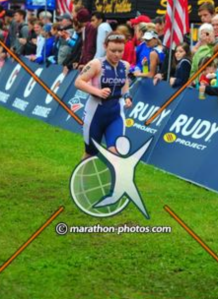
This is awkward, I should be finishing on empty, but instead I’m running in zone 2. Let’s just look at the grass…
Overall, I’m super thankful for the experience of training for and racing at nationals with great teammates and competitors. Thanks to everyone who made for an unforgettable weekend!
See you next year Clemson!
Posted in Uncategorized
Tagged clemson, collegiate triathlon, cycling, race, race recap, race report, road biking, sc, tri, triathlon, uconn, usa triathlon collegiate national championships, usatcn15
1 Comment
It may be June, and Nationals may have been 2+ months ago, but here I am finally sitting down to recap my experience at USA Triathlon Collegiate National Championships. Before I recap the race, I’m going to explain my journey to nationals since I didn’t exactly plan on a national championship race being my first triathlon.
I knew I wanted to join the triathlon team when I got to school in the fall so I immediately joined (read: stalked) them on social media and attended the first informational meeting and found out that the team was already in the middle of their season. Based on the way the Collegiate Triathlon season is set up, the team must sign up and plan for the races during the summer. Fortunately, I learned I would be able to join the team for one race at Buzzards Bay. I had done very little training for the swim and run, but figured that as an endurance athlete, I could survive a simple sprint triathlon.
At the time I didn’t have tri clothes, nice googles, or a wet suit. I convinced my parents to pick me up so I could go shopping for these important items because I knew I wanted to seriously get into the sport.
Unfortunately, the weather was super rainy the day of the race. Due to rip tides in the ocean, the swim portion got cancelled; instead, the race director decided to turn the race into a duathlon, which is a run, bike, run. I was relieved that I didn’t have to go into the rough water for my first open water swim ever, but I was disappointed that I didn’t get to complete my first triathlon.
Flooding in the transition area.
Racing
I did get to meet up with some of the YoungTri girls at the race!
I waited until spring semester to do any more races. I didn’t think I was going to go to Nationals because I thought I needed to qualify, but my teammates had me as the backup for the female team. When one grad student couldn’t go, they asked me. I almost immediately thought it would be way too expensive since I didn’t qualify, but luckily my school is super awesome about making the trip totally affordable for us broke college kids.
I created a super rough training plan and just decided to go for it!
I did school work nonstop for the entire week before and then I was off to Tempe!
On race day, we arrived in Tempe and I made it to the swim warm up with only a few minutes to spare. I hopped in and got really nervous. Swimming is by far my least favorite and weakest discipline. I had never done an open water swim before, but I figured Nationals was a GREAT place to start (extreme sarcasm here). Luckily, my goal was simply to survive and enjoy the swim.
Swim
When I swam out with my wave to the starting point, we were so close together and I immediately found myself treading water in the middle of the pack and simultaneously kicking and getting kicked by everyone around me.
My wave about to begin. I was excited to be in the last wave so I didn’t have to worry about anyone passing me.
I told myself I had to stay calm and not worry about pace at all. I knew the shape of the course and once I got over the initial shock of swimming in open water for the first time, I got into a rhythm and had no issues sighting. I think this was the fastest a swim every went by for me. Before I knew it I was exiting the water (so very far from the front of my wave) and getting pulled up onto the stairs by a volunteer.
Swim complete.
Time: 33:03 (2:00/100 yards).
I ran into transition and grabbed my bike. I smiled leaving because I knew my family was watching the live webcast back home.
Bike
I hopped on the bike thinking “yes, this is my thing!” I love the bike and couldn’t have been any more happy knowing the swim was over.
The bike course was two 18K loops (slightly shorter than the average olympic distance of 40K). There were virtually no hills and 2, 180 degree turns on each loop. I liked the course since I could easily click into a hard pace and try to maintain it all the way.
I don’t have aero bars and for some reason I got lazy and didn’t ride in the drops for over half of the race.
I pushed the bike fairly hard and managed to pull off 20 mph for the entire course. Pretty solid considering my lack of aero-ness (that’s definitely a word). I pretended there wasn’t a run afterwards because I know I’m a better cyclist than runner and no matter how hard I pushed myself, I would still be tired on the run.
The second loop of the bike course was even better because I knew the tangents, so I just continued to push it and have fun.
Time: 1:07:37 (19.9 mph)
Run
Two legs down, one to go. I started the run out with a first mile around 7:30. I knew that was fast and inevitably slowed down during miles 2-4. The run was pretty flat except for going up onto the two bridges, which at this point in the race did feel like hills. The volunteers were super nice and threw water at us since it was climbing into the mid to high 80s.
Overall, the run wasn’t too eventful, but I did debate stopping to use the bathroom because I definitely ate way too much before the race, which caused some bad GI issues (I should definitely know this by now…). I only ate one gu during the bike. Next time I’ll eat less before and fuel more during the race.
I came into the finish line and sprinted as I heard them announce my team. I love doing collegiate races in triathlon and cycling because the atmosphere is so energetic and exciting.
Time: 51:46 (8:19 pace)
Total time: 2:36:53
I was so happy to have come in under 3 hours!
With Caitlin after the race.
Later in the afternoon, my team raced the Mixed team relay, which was 23 minutes of pain. It was short and completely different than the olympic distance in the morning.
Nationals was such a great experience and I hope to go back every year in college!
Until next time, Arizona.
Time Management
I like to think I’m very type-A. I enjoy organizing, making lists, being on time, and goal setting. One might think theses qualities make me a pro-time manager, but as I realized during my freshman year of college, even the most type-A people struggle to fit everything into a 24 hour period. Here are my tips on being an effective time-manager:
1. Keep a calendar. I prefer writing everything down on a desk calendar because it’s always in front of me, but if a phone/computer calendar works for you, go for it! At school I write down club meetings, weekend trips, volunteer events, and any other events I may need to attend. I like to draw little pictures and use different color sharpies and pens to make it look more appealing on my boring desk. I also write down any exams I have and highlight the dates.
The only picture I have of my freshman year calendar.
2. Keep a planner. I like to keep a planner of all my school work. At the beginning of the semester, I go through all my syllabi and write down EVERY due date. It takes me a little while, but then I never forget any homework. During the summer, I keep a planner of my work schedule, races, and other social events. I recommend getting a planner that you really like so you actually want to use it. Here’s my planner that I just purchased from Vera Bradley.
3. Make lists. I always find myself making lists: packing lists, to-do lists, grocery lists, bucket lists, etc. (Notice how this blog post is also a numbered list). I have a notebook that I purchased at Target that I use to write to-do lists and any other ideas that come to me throughout the day.
During the school year, most of my to-dos are school-related, so a lot of my other chores may not get done on the first day I add them to the list. However, during the summer, I have A LOT more free time so I try to complete my tasks ASAP. This gives me something to do and ensures that I don’t waste my day browsing the internet.
4. Don’t expect to perfectly follow a planned schedule. During my first semester at college, I quickly realized that I wasted a significant amount of time doing nothing. I started researching time management tips and almost every source I read listed making an hourly schedule. I use to make very specific schedules–sometimes for multiple days at a time–of every minute of my day. I thought that I could manage constantly being productive from the time I woke up until the time I went to bed. While this seemed to be a great plan, I didn’t include time to do small things that I know I’ll do in a day like check social media, call my parents, and sit and talk to my roommate. While its great to have a planned schedule, you’re not a robot and you cannot expect to sit down and do work all day.
I suggest going back to the to-do list and write down the things you NEED to get done today and things that you’ll do if you have extra time. Maybe you’ll have an idea of when/how much free time you have, but don’t worry about planning every second of your day. You’ll be less stressed if you’re not constantly straying from your ideal schedule.
One thing I did during finals week was plan out the assignments I wanted to complete each day.
This wasn’t a strict schedule, but it helped me plan out an effective order to complete my assignments in.
5. Compartmentalize your life. When you’re working, you’re working. When you’re relaxing, really take the time to relax. I’m guilty of going to the library to work on an online assignment then wandering away from my work and reading blogs. While this makes me happy in the moment, I later become very stressed when I realize how long a simple assignment is taking me.
Designate time for different activities. For example, on a typical Sunday, I may tell myself that I’ll sleep in and relax until 9 or 9:30, then I’ll meet up to run with a friend and have brunch, call my mom and shower, but from 12-4 I’ll go to the library and do chem problems. When I’m with my friends and relaxing in my room, I’ll enjoy my free time, but at 12 it’s time to focus on school work and not get distracted. I might bribe myself by making plans to meet a friend for dinner or have a movie night with my roommate. I really believe that being busy keeps me focused in school because I know that my work time is limited, so I need to make the most of it.
I’m sure there are plenty more time management tips, so feel free to share your’s!
Happy Summer!
Get Outdoors
Are you one of those people who struggles to get to the gym? Does another hour-long elliptical leave you dashing for your comfiest sweatpants, froyo and netflix? Can you not stand the thought of sitting on a spin bike for ten minutes? If so, have no fear. You are so not alone.
I am a self-proclaimed outdoors-lover. I try to exercise outdoors as much as possible; however, living in New England makes it a struggle to fit in outdoor workouts in the middle of winter.
As much as I love staying active and training, I can’t stand staying stationary for very long. Treadmills bore me, the bike trainer makes me want to ride in the cold and ellipticals (even the nice one at my gym with personal TV’s) seem way too monotonous to do for extended periods of time (and by “extended periods of time”, I mean two or more minutes). I usually don’t see a reason to stay inside when I can explore the great outdoors and get a change of scenery.

The area around my school may be hilly, but it’s so scenic. I almost always try to run and bike off campus.
Spending hours in the gym doesn’t appeal to me when I can get outdoors, but the frigid temps have made road biking impossible some days. Last week, it was only 15 degrees with a feels like temperature of 5, so I put on two pairs of glove liners to go out riding. My dad and I started to make our way to meet his group, but after two miles, my fingers were incredibly painful, so we turned around. He still rode a century later in the day, but I ended up going to spin with my mom. Normally I would feel guilty about ditching a group ride due to being uncomfortable, but I would’ve gotten frostbite if I attempted to ride 40+ miles without the proper gear.
Last year I thought winter riding was completely out of the question, but then I saw the local riders heading in temps way below freezing with snow still on the shoulders of roads. Because I never rode in the winter before, I don’t yet own the proper gear. I need a new bike jacket and gloves, but I don’t want to buy this gear until I order it from my cycling club this upcoming semester. I already spend way too much money of bike gear.
I have typically been wearing underarmor as a base layer, then a turtleneck, my north face jacket followed by an outer wind breaker, but this gear is definitely not ideal for winter riding.
Having the proper gear is definitely key to successfully completing outdoor workouts during the coldest months of the year.
It’s amazing just how many workouts you can get in outside just by wearing the right clothing. I find that running in the cold is a million times easier than biking in the cold because there’s much less wind chill because you’re moving slower.
Unfortunately the recent negative temperatures, icy sidewalks and narrow/unplowed roads have also made running difficult. I don’t like to make excuses with the weather, so lately I’ve been doing the rollers and trainer in my house, core workouts, strength training at the gym, running on the treadmill, rowing on the erg, swimming and going to spin class, but I really don’t enjoy any of these workouts. I miss biking outside and running on trails. Because I haven’t been able to enjoy the physical activities I enjoy the most, it’s been really hard to stay motivated. I’m always wondering what to do for workouts and I’m finding it harder keep pushing myself.
In order to help myself and others, I’ve made a list of tips to help others (and myself) get out of the winter training rut:
- Get together with friends as much as possible to workout: I’ll be back at school in a few weeks, which means there will be lots of friends to run and bike with. I’ll keep taking advantage of living in such close proximity to them.
- Go to the bike shop to spin whenever possible and go on group rides: While I’m still on winter break, I’ll try to workout with my local bike club with my dad.
Luckily I was able to head out for a group ride last Sunday. It was an endurance pace for about 65 miles. I ended up with 80 for the day with riding to and from the shop with my dad. The ride was super scenic, not overly hilly (it had 3,000+ ft of elevation gain in 65 miles, but it was gradual on the way out and fast on the way back) and fun. I had to opportunity to talk to a few younger riders about collegiate racing and learn how to ride in the winter. The next day I was super tired but managed to fit in a 20 mile solo recovery ride and a 20 minute swim after work.
- Pick a summer goal race and SIGN UP before I go back to school. I’ve kind of been procrastinating on this one since I don’t yet know how much time I’ll be able to take off from my summer job, but I think it’s time to just sign up and create a structured training plan. Another reason I have yet to sign up is because I don’t know what weekends in the spring I’ll have bike races or what my cycling team training will be like.
- Try to go to at least one group exercise class every other week. Last semester I went to two group classes. I know after college I’ll look back and regret not taking advantage of the free classes on campus. They’re also a great way to workout with my friends who aren’t into running, cycling or swimming.
- Do intervals indoors and endurance work outdoors. At school I won’t have my rollers or trainer so I might be running a lot more, but I’m always a fan of doing my slower runs and rides outdoors because in the winter, it’s hard to go fast anyways. Then, I do my short, more intense rides and runs indoors because I don’t enjoy staying at a single speed for too long.
- Do winter sports. If I have the opportunity to cross country ski, downhill ski (my favorite!) or do anything winter related, I always take advantage of it. It’s a way to get outside and spice up my workouts.
I know winter isn’t the ideal time to swim, bike, or run, but it’s important to at least keep a base fitness level, so that you can fully enjoy exercising in the warmer months.
Feel free to share your winter workout triumphs and struggles below.
Happy January!
Ariana
Posted in Uncategorized
Tagged biking, collegiate cycling, cycling, new england, new england winter, outdoor, outdoors, running, swimming, training, tri, triathlon, triathlons, winter training
Leave a comment
It’s New Year’s Time
I love organizing. My room is (almost) always abnormally clean. I make to-do lists, shopping lists, goal lists and any other kind of list that keeps my organized.
During the holidays (and let’s be honest: by “the holidays”, I really mean the time period from mid-November until after the last holiday ends the first weekend in January), I, like many other people, tend to let myself go. While I still bike, run, hit up the gym and eat healthy foods, I also eat more sweets than any one should ever have, cut my workouts short and sit around for unhealthy amounts of time. After this fun, but not-so-healthy period, I’m excited to start fresh. While a new year is merely a meaningless unit of time, I find it mentally motivating to think of it as a fresh start. I hate the “new year, new you” slogans that seem to appear every year after the holiday season, but I can’t help but create my own new beginning. During the cold, dark winter, the possibilities of a happier, more lively self excite me.
2013 was a big year for me; I experienced my first injury from running, graduated high school, went to Europe for the first time and started college. I remember this time last year frustratingly feeling like the college application process would never end, but before I knew it the senior events started and school work was a distant memory (hello senioritis). With all these events going on, I often lost sight of my New Year goals; however, looking back on the year, I realized that despite my transition year, I still managed to get good grades, compete in a duathlon (which was suppose to be my first triathlon, but due to strong currents, the swim got cancelled), PR my 5K, make new friends, take risks and immensely improve my cycling. It truly was a great year, but I know 2014 will be much better.
I am so thankful to have been randomly paired up with a roommate who I get along with almost perfectly. We’re not only good roommates, but also great friends. I was super worried about the roommate situation, and honestly, it could’ve turned out a lot worse, but it didn’t. I survived my first semester away from home, but it wasn’t easy. I was pretty miserable the first two weeks, I struggled with time management for the first time, and I constantly worried if I was being social enough. My workout time decreased drastically as I traded time on my bike for time in the library, and on top of that, my eating was kind of out of whack. However, now that I’m done, I can look back and think about how much easier the next semester will be. I can finally focus on doing well in school and enjoying my time in college.
Knowing that I’ll have my college life more organized means I’ll most likely be more successful with my New Year’s resolutions. Hopefully these aren’t too cliche or cheesy.
So here they are:
My 2014 New Year’s Resolutions:
- Live by the slogan “work hard play hard“: Before college, I knew that many students struggle with time management, but I never thought I would be one of them. I had so much unstructured time and so much to do. I’d heard the “2-3 hours of homework for every hour in class” calculation countless times, but I soon realized that was all too simple. I definitely felt like I was spending at least that amount on homework, but truthfully I was spending that much time (or more) pretending to do work. I would surf the internet for hours, procrastinate workouts, and spend time doing anything and everything while “doing” work. After Thanksgiving break, I had a week and a half to get the most work I’ve ever had in my life done. I knew I had to crank it out. I realized that to do well in college I had to really focus on my work and commit myself to mastering the course material. I also learned that I do have enough time to do this, but I need to focus when doing work so I have time to relax, workout, or take time for myself and not worry about school work during my free time.
- Commit myself to my sports (running, cycling, and triathlons): While I can be disciplined with workouts,
I don’t always support those workouts with the best diet. Most of the time I eat extremely healthy, but I don’t always focus on the amount of food my body needs. During the summer, I increased my training load to where I was riding ~300 miles a week. One would think I would easily lose weight, but I didn’t. I was constantly hungry and overestimated the amount of food I really needed. High training loads DO NOT give me the ability to eat anything and everything I want. I need to be disciplined and strategic with what I eat because it will affect my ability to workout.
- Make new friends: I will continue putting myself out there and trying to make new friends like I did this year.
- Do a triathlon: I don’t see this not happening (double negative much?)
- Read literature, practice spanish and continue to be somewhat studious during the summer: Nothing too serious or unenjoyable, but I tend to do absolutely nothing intellectual during the summer.
- Continue to enjoy every situation as much as possible: If I have to spend hours in school, I might as well try to be interested by the material. If I’m bored of biking or running, I’ll recruit friends, try out new workouts, and enjoy the beautiful New England scenery. Life can (and should) be enjoyable.
Posted in cycling, duathlons, goals, motivation, new year's resolutions, running, triathlons, Uncategorized
Tagged 10k, 5k, adjusting to college, college, cycling, duathlons, europe, goals, graduations, new england, new year's resolutions, paris, resolutions, road biking, running, triathlons
Leave a comment
Biking Vs. Running: Which One Do I Choose?
Good morning everyone (or, you know, the one reader I’d be lucky to have).
Today I woke up and the world just seemed to scream “REST DAY!”
I did not protest. Instead, I stayed in bed until the lovely hour of 8:15 then made myself get up so I could eat breakfast and actually be able to fall asleep at a decent hour tonight. I then proceeded to peruse the internet for the next few hours.
Lately I haven’t been spending too much time prancing around the streets and trails of CT in my sauconys.
Remember when I PR’d my 10K by 3+ minutes, held a 7:18 pace, and beat my dad to the finish by 1 net second? #missingmyspeed
At first I didn’t even miss running (shocker, I know). However, when I look at pictures of my “summer bucket list” runs, I can’t help but wish I was at least able to complete the occasional run without experiencing abnormal shin pain.
One of my bucket list runs.
I’m still loving the endurance athlete lifestyle, but I’ve made a pact to completely abstain from running until I am 100% sure I’m recovered from my injury.
It’s funny how other people associated me as a runner. Since I’ve stopped running (regularly), I’ve had people who lived along my normal routes ask why they don’t see me running by their homes anymore. Others will ask me how my running is going. I usually just casually say I’ve gotten into biking. I’m pretty sure they don’t understand, but that’s cool. Instead of looping my town, I’m off crossing state boarders and climbing mountains on my bike.
Exploring on the bike is so much better than running. Everyday I feel so lucky when I’m out riding. I see beautiful New England landscapes that the casual neighborhood runners don’t get to experience.
 Most of the time I’m not taking pictures on my rides because I find it quite disruptive to pull my phone out of my saddle bag, but every so often when I’m on a solo ride, I’ll take it out during a Clif or Lara Bar break.
Most of the time I’m not taking pictures on my rides because I find it quite disruptive to pull my phone out of my saddle bag, but every so often when I’m on a solo ride, I’ll take it out during a Clif or Lara Bar break.
I should turn my recovery rides into “ride to the prettiest places and stop to take pictures every 2 miles” kind of rides.
Just for fun, here’s a few signs that I’ve stopped indentifying myself as a runner and now consider myself a cyclist:
1. I’ve merely skimmed the issues of Runner’s World that come in the mail. After my lack of excitement over the magazine, my mom finally suggests we cancel the subscription.
2. I frequently visit bicycling.com.
3. I dismiss the local running store’s emails about training tips and local events.
3. I paid $35 to join a local cycling club and now proudly wear the jersey.
4. I’ve already emailed the cycling club president at the college I’m going to next year and have stalked their facebook group for some time.
5. I felt more accomplished after successfully changing my first practice flat tire than I have after any ride or run.
6. I’ve looked up how my bike is going to fit into my college dorm room. It’s coming along.
7. I told my mom I’m bringing my bike on our two night “vacation” to NJ to visit family. I need to get a good ride in. It’s so fun to ride in different places. You see so much more than on foot.
8. I’ve searched endlessly for the perfect Saturday morning group ride in NJ to replace my normal shop ride.
Although these are just a few new behaviors of mine, it’s fun to see how a change in exercise routine can change my daily life.
This post isn’t meant to put running down. Truthfully I do miss it. I miss going out for 45 minutes and still getting a workout in. I miss not having to deal with mechanical issues. I miss the simplicity (and safeness) of running races. All these things I don’t find in biking.
Of course there are pros and cons to every sport and activity. Why choose just one? Let’s try 3!
Swim. Bike. Run.
I’m uber curious about triathlons. I could do three sports and not spend too much time on any one.
However, one of the reasons I think I’ve developed posterior tendonitis (shin splints) is because I’ve gained weight. I don’t believe I’ve gained weight from the occasional froyo visit or from the double desserts during my trip to France and Italy (though those definitely don’t help). I think I’ve gained the weight slowly as I started to increase my training volume.
Let’s take it back to summer of 2011.
I had just finished my first season of competitive running, my sophomore year of track. I was running more than I ever had (probably about 25 miles per week) and I was running faster than I ever had. I was about to go on a teen tour out west with 50 other teens whom I had never met. I was psyched, but it meant I’d be going 3 weeks without exercise and eating restaurant and hotel food…or so I thought.
I was at my lowest weight EVER on the trip. I was by no means small or skinny, but I was pretty healthy.
I ended up running with my new friends and working out in the gyms on top of the other activities we were doing, but I was still buying trail mix and chex mix at road stops and eating big portions of it while sitting on the bus, eating in chain restaurants, and eating dessert everyday. I tried to eat salads and veggie/turkey burgers most of the time, but overall I still don’t understand how I came home 1lb lighter. Can I just have this happen all the time please?
Then right when I came home, I decided to sign up for my first half marathon. I completed long training runs with my groups on Saturday mornings. I loved it, but I thought that because I ran 10 miles in the morning I could eat 4 slices of pizza, dessert, and anything else I wanted. Let me tell you, I was so WRONG. Long workouts DO NOT give you the ability to eat however much you want. You can have a treat once in awhile but you cannot gorge on foods because you worked out. That’s not beneficial at all.
I completed the half marathon during my first varsity cross country season while I managed to put on 10 lbs!! I was overcompensating for my workouts by eating way more than I needed. Watch as this theme comes up over and over again.
First half at 10 lbs heavier. I ran 1:52:11, but I thought I was going to have to race a XC 5K a few days later. Still a solid first half time.
I then maintained my weight for a while. I knew I’d be faster if I just dropped 10 lbs, but I never wanted to push myself like that.
Fast forward to the worst of it all. In January 2013 while running winter base mileage, I started having shin problems. I pulled back and cross trained for a few weeks, but the pain returned and got worse during my senior year of track.
At this point, I was running such low mileage that I was having a hard time maintaining my weight. I started to put on even more weight.
I reached my heaviest weight in the summer of 2013. I started biking high mileage, but again I increased my calorie intake even more. No amount of mileage could compensate for my eating. Although I was eating extremely healthy (95% of the time), I was eating such large quantities of food that my body managed to pack on the pounds.
Now I’ve realized what I’ve done. I feel fast on my bike because I know I have a good cardiovascular engine and I keep up with 20mph group rides just fine, but I’m learning to eat when I’m hungry and stop when I’m full.
My reward for losing weight will not be improved aesthetics, but the faster, stronger athlete I will become.
While some people’s weight loss incentives might be a new bikini or a trip to their favorite spa, mine will be my return to running.
At some points I thought I should just give running up for good and stick with cycling, but I shouldn’t have to choose. Rest, physical therapy, and icing all failed to improve my shins. I know weight loss will help bring my center of gravity back to the way it was before. I’ll put less strain on my body while gaining muscle to help me move faster.
Once I get to my normal weight and my shins heal, I’ll begin to run again. Until then, you can find me on my bike trying to get more Queen of the Mountain ranks on Strava and conquering the local group rides.
Posted in Uncategorized
Leave a comment




























